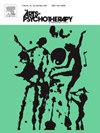青少年心理健康困难的艺术心理治疗:作用机制和结果的系统回顾和逻辑模型
IF 1.5
3区 心理学
Q3 PSYCHOLOGY, CLINICAL
引用次数: 0
摘要
缺乏证据基础来理解和评估艺术心理治疗(艺术心理治疗、舞蹈运动心理治疗、戏剧治疗和音乐治疗)干预措施,这些干预措施越来越多地提供给有心理健康困难的青少年,这一人群的需求不断增加。我们的目的是了解哪些艺术心理治疗干预措施用于有心理健康问题的青少年,以及它们的作用机制是什么。我们的目的是评估艺术心理治疗干预的结果是什么,以及它们是如何测量的。文献来源通过数据库检索(CINAHL, EMBASE, Cochrane Library, PsycINFO, PubMed, Scopus, APA PsycNet)和手工检索(2007年1月- 2023年6月)。共筛选论文3403篇,其中47篇符合纳入标准。评估纳入研究的偏倚风险。研究结果以叙述的方式进行了综合,并绘制了一个逻辑模型,绘制出干预成分、潜在的作用机制(一般心理治疗因素和艺术心理治疗独特的因素)和干预结果。所产生的逻辑模型可以为跨艺术心理治疗方法的更一致的评估策略提供信息。尽管通过叙事综合认识到共同的结果,但用于评估这些方法的效益的结果测量方法范围广泛。这是建立强有力的证据基础的障碍,因为它强调差异而不是共性。本文章由计算机程序翻译,如有差异,请以英文原文为准。
Arts psychotherapies for adolescents with mental health difficulties: A systematic review and logic model of mechanisms of action and outcomes
There is a lack of evidence base to understand and evaluate arts psychotherapies (Art Psychotherapy, Dance Movement Psychotherapy, Dramatherapy and Music Therapy) interventions increasingly provided for adolescents with mental health difficulties, a population with rising need. We aimed to understand which arts psychotherapies interventions are used with adolescents with mental health difficulties and what their mechanisms of action are. We aimed to assess what the outcomes of arts psychotherapies interventions are, and how they are measured. Literature was sourced through database searches (CINAHL, EMBASE, the Cochrane Library, PsycINFO, PubMed, Scopus, APA PsycNet) and hand searches (January 2007 - June 2023). 3403 papers were screened, 47 met inclusion criteria for synthesis. Risk of bias in included studies was assessed. Findings were narratively synthesised, and a logic model drawn, mapping out intervention components, potential mechanisms of action (generic psychotherapy factors and factors unique to arts psychotherapies), and intervention outcomes. The logic model produced can inform more consistent evaluation strategies across arts psychotherapies approaches. Despite shared outcomes recognised through narrative synthesis, there is wide range of outcome measures used to assess benefits of these approaches. This is a barrier to establishment of a strong evidence base as it emphasizes differences rather than commonalities.
求助全文
通过发布文献求助,成功后即可免费获取论文全文。
去求助
来源期刊

Arts in Psychotherapy
Multiple-
CiteScore
3.20
自引率
11.10%
发文量
66
期刊介绍:
The Arts in Psychotherapy is a dynamic, contemporary journal publishing evidence-based research, expert opinion, theoretical positions, and case material on a wide range of topics intersecting the fields of mental health and creative arts therapies. It is an international peer-reviewed journal publishing 5 issues annually. Papers are welcomed from researchers and practitioners in the fields of art, dance/movement, drama, music, and poetry psychotherapy, as well as expressive and creative arts therapy, neuroscience, psychiatry, education, allied health, and psychology that aim to engage high level theoretical concepts with the rigor of professional practice. The journal welcomes contributions that present new and emergent knowledge about the role of the arts in healthcare, and engage a critical discourse relevant to an international readership that can inform the development of new services and the refinement of existing policies and practices. There is no restriction on research methods and review papers are welcome. From time to time the journal publishes special issues on topics warranting a distinctive focus relevant to the stated goals and scope of the publication.
 求助内容:
求助内容: 应助结果提醒方式:
应助结果提醒方式:


